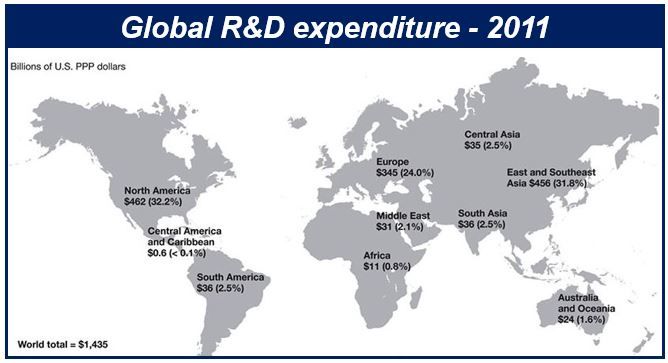American scientific leadership has shrunk over the last ten years, as China, South Korea and some other nations raise their innovation capacities and close the gap.
The data comes from ays a National Science Board (NSB) report titled “Science and Engineering Indicators”.
The report authors informed that taken together, the Asian countries today represent a larger proportion of global research and development (R&D) than the US, while “China performs nearly as much of the world’s high-tech manufacturing as the U.S.”
The biennial report clearly shows that the US, Europe and Japan are no longer dominate the R&D arena. Since 2001, America’s share of global R&D has fallen from 30% to 26%, while Europe’s declined from 26% to 22%.
Since 2001, Asian countries’ share of global R&D increased from 25% to 34%, with China growing from 4% to 15%.
American scientific leadership gradually giving way to Asia
NSB Chairman Dan Arvizu, who is also the director and chief executive of the National Renewable Energy Laboratory, said:
“The first decade of the 21st century continues a dramatic shift in the global scientific landscape. Emerging economies understand the role science and innovation play in the global marketplace and in economic competitiveness and have increasingly placed a priority on building their capacity in science and technology.”
South Korea and China have boosted their countries’ R&D by making considerable investments in the science and technology (S&T) research businesses and S&T training at colleges. The number of researchers in China between 1995 and 2008 increased three-fold, and doubled in South Korea from 1995 to 2006.
A growing number of students in South Korea and China are finding excellent prospects for advanced education in science and employment at home.
Emerging economies investing in R&D wisely
Not only have these countries invested heavily in research and teaching enterprises, they have also concentrated their attention on vital sectors of the economy, including clean energy and high-tech manufacturing.
China’s high-tech manufacturing volume grew nearly six-fold between 2003 and 2012, increasing its global share of high-tech manufacturing to 24% from 8%, biting at the heels of the US’ 27%.
Emerging economies invest much more today in clean energy, a vital industry for this century, than the advanced economies. In 2012 they invested almost $100 billion in clean energy, mainly solar and wind, with $61 billion of that investment coming from China. The US, on the other hand, only invested $29 billion in clean energy in 2012.
Parent companies of American multinationals perform over four-fifths of their global R&D at home. However, these companies’ R&D investments are rapidly growing in China, India, Brazil and some other emerging economies, which the authors say both reflect and further contribute to a more globally-distributed R&D landscape.
In a press release, the NSB wrote “Majority-owned foreign affiliates of U.S. MNCs, for example, tripled their R&D investments in India and more than doubled them in Brazil between 2007 and 2010, nearly reaching the expenditure levels of the U.S. affiliates in China.”
US R&D recovers from the Great Recession
2009 saw a steep decline in business R&D, which makes up most of the research and development that occurs in the United States. A temporary rise in Federal R&D funding through the 2009 American Recovery and Reinvestment Act helped to partly offset the decline in overall R&D activity during the Great Recession.
According to comprehensive data gathered and analyzed by the authors, it appears that the US has recovered from the Great Recession better than its rival advanced economies. By 2011, US R&D returned to 2008 levels after adjusting for inflation.
It appears that S&T degree and job holders fared better during the recession than workers in other sectors of the economy.
The NSB pointed out “The report released today does not cover the period during which Federal R&D was cut sharply by sequestration. The National Science Foundation reports that Federal R&D funding has declined in each fiscal year since 2010, dropping by 7.1 percent in fiscal year 2013.”
US high-tech industries recovered rapidly
In the aftermath of the recession, American high-tech industries have fared better than those in other rich nations. Unlike Japan and the European Union, the value-added output of US high-tech industries increased in 2010-2012, overtaking pre-recession levels. “Similarly, commercial investment in clean energy technology declined sharply in the E.U. during the recession and has yet to return to pre-downturn levels,” the NSB added.
Ray Bowen, NSB member and chairman of its Committee on Science and Engineering Indicators, which oversees development of the report, said:
“The United States remains the world’s leader in science and technology. But there are numerous indicators showing how rapidly the world is changing and how other nations are challenging our predominance.”
“As other countries focus on increasing their innovation capacities, we can ill afford to stand still. We now face a competitive environment undreamed of just a generation ago.”

